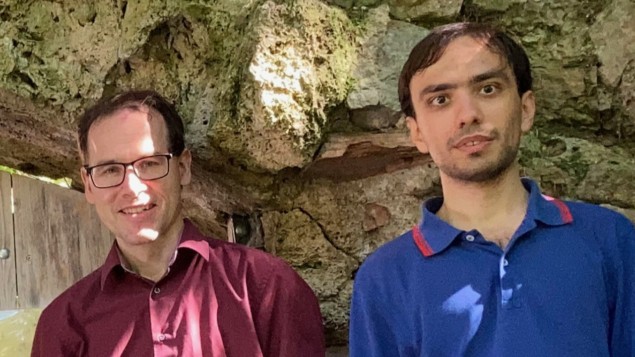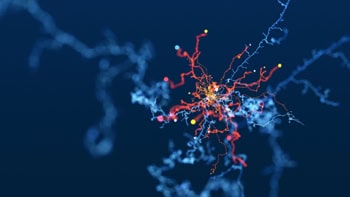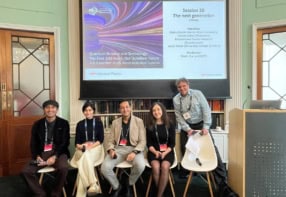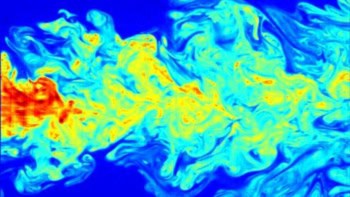
As quantum technology improves, researchers are able to connect increasing numbers of components to create nascent quantum computers. An important challenge is knowing what components and configurations have the most potential for creating useful systems. Now, Leopoldo Sarra and Florian Marquardt have shown how machine learning can be used to implement the deep Bayesian experimental design of large-scale quantum networks.
Marquardt is based at the Max Planck Institute for the Science of Light in Germany, where the research was done. Sarra has since moved to the Flatiron Institute in the US, from where he spoke to Physics World about the research.
What is deep Bayesian experimental design?
Experimental design is the branch of science that deals with the selection of experiments to be performed to characterize a physical system or phenomenon. When designing a new experiment, scientists must consider the hypotheses they want to test or falsify, and prioritize those that are likely to be more useful. There are often very complicated dependencies between the physical quantities of interest and the accessible quantities scientists can observe. The implications of an experimental result are usually not obvious.
Bayesian experimental design is a technique for automatically identifying the most useful experiments that will allow us to understand as much as possible about a physical system. In particular, starting from some initial knowledge or expectation about a system, it builds a statistical model that quantifies the uncertainties in our knowledge and how they change when a given experiment is performed. Thus, it quantifies the utility of an experiment and, therefore, finding the most useful one.
However, this technique is known to be computationally very expensive. Traditionally, very rough approximations (or even just heuristics) were needed to make it feasible. With the recent development of artificial intelligence techniques such as neural networks (also called “deep learning”, hence the word “deep”), it is now possible to make much better approximations of the Bayesian technique, leading to more efficient and accurate results.
What are the main challenges facing people who are designing quantum technology platforms?
Present-day quantum devices are extremely challenging to build and operate. They are strongly affected by interference and environmental noise, which can undermine their reliability and the ability to build large devices by connecting many of them together. In particular, despite manufacturing efforts to produce identical devices, each component will always be slightly different due to fabrication imperfections, and thus will have a slightly different behaviour than expected. In addition, a component’s behaviour may also be affected by environmental conditions (such as temperature fluctuations, ambient noise, etc.). Therefore, the ability to understand the actual operating regime of a device and to properly account for and correct these deviations from the expected behaviour becomes crucial.
How can deep Bayesian experimental design help solve these problems?
Since it is simply not possible to manually characterize each quantum device each time before use, automated techniques must be employed. Bayesian experimental design provides a way to characterize a quantum system with a minimum number of measurements. It can be used to compare different approaches and understand the most efficient ones. While manually-designed strategies can provide a solution, we expect Bayesian techniques to be much more efficient, providing faster and more accurate results. Their advantage is twofold: first, they tell you how to incorporate the result of a new experiment into previous knowledge; second, they tell you which experiment to run next. Any inefficiency in either step would result in longer characterization times or lower accuracy.
What you have done in your paper “Deep Bayesian experimental design for quantum many-body systems”?
In this work, we took from some of the state-of-the-art techniques in artificial intelligence that deal with the estimation of the quantities necessary to use the Bayesian framework, and we investigated their possible application to quantum systems. The goal was to understand how useful they can be for characterizing a quantum device, how efficient they would be, and what technical challenges need to be overcome for future practical applications. We considered some of the most common platforms (coupled cavities and qubit arrays) and explored the application of these techniques to find their operating parameters. We compared the efficiency with some more naïve characterization strategies, such as performing random measurements or uniform measurements in a parameter range. We also studied the effect of different design choices as well as the impact of noise in the predictions.
What did you find and how could it further the development of quantum technologies?
Deep Bayesian experimental design provides a way to update the knowledge of the system’s parameters and their uncertainty after each measurement in situations where the relationship between the measurement result and the parameter update is not trivial. While standard techniques typically find only a single outcome that is most likely to describe the system, a deep technique approximates the entire distribution. As a result, it can reveal the limits of a given characterization strategy. If the uncertainty of a parameter does not decrease after many measurements, it typically means that the measurement setup does not allow unambiguous determination of that parameter.
By looking at the selected measurements, we see that “effective strategies” emerge that combine the exploration of different measurement settings (where the most relevant measurement configurations are identified) and the exploitation of the identified settings to reduce the uncertainty.
Furthermore, we have shown the advantages of an active characterization strategy, in which each experiment (next measurement) is chosen to maximize utility, compared to other simpler measurement strategies. For efficient characterization of a quantum device, which may depend on many different parameters and be affected by various sources of noise, performing random measurements that do not take into account previous results is clearly suboptimal.
Future developments of this technique will lead to much more reliable quantum devices. Machine learning aids studies of quantum magnets
It sounds like you will be following up this work with further research
With this work, we have shown that deep Bayesian experimental design provides concrete advantages in the characterization of quantum systems compared to simpler techniques. The next steps would be the technical improvement of the presented method to allow fast applications on real quantum devices and the possibility to scale up to larger systems. While currently the algorithm has to be re-run after each measurement, one possibility would be to first learn an entire measurement suggestion strategy through many simulations, and then use this faster predictor for use with the real device.
More generally, the ability to have a model of a physical phenomenon, to assess its uncertainty, and to understand which experiments are most useful to improve it is the basis of the scientific method. While currently we simply model the quantum system with some unknown parameters, and different experiments simply correspond to different measurement settings, we can envision a future algorithm that acts as a kind of “artificial scientist”, capable of exploring a physical phenomenon on its own. The study of Bayesian experimental design in quantum techniques will also lead to advances in this longer-term vision.
- Sarra and Marquardt describe their research in “Deep Bayesian experimental design for quantum many-body systems” which is published in Machine Learning: Science and Technology.



